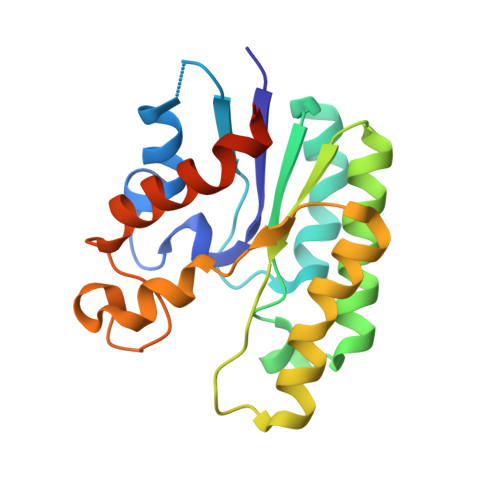Substrate specificities of Escherichia coli thioesterase I/protease I/lysophospholipase L1 are governed by its switch loop movement
Lo, Y.-C., Lin, S.-C., Shaw, J.-F., Liaw, Y.-C.(2005) Biochemistry 44: 1971-1979
- PubMed: 15697222
- DOI: https://doi.org/10.1021/bi048109x
- Primary Citation of Related Structures:
1U8U, 1V2G - PubMed Abstract:
Escherichia coli thioesterase I/protease I/lysophospholipase L(1) (TAP) is a multifunctional lysophospholipase and acyl-CoA thioesterase with a SGNH-hydrolase fold. The relationship between TAP's structure and its versatile substrate specificity, however, is unclear. Here, we present the crystal structure of TAP in complex with octanoic acid (TAP-OCA; OCA, a free fatty acid with eight carbon atoms, C(8)). A structural comparison of native TAP with TAP-OCA reveals a remarkable conformational change in loop(75)(-)(80), called "switch loop movement", upon OCA binding to the substrate-binding crevice of TAP. OCA binding to the substrate-binding crevice results in a continuous hydrophobic surface, which triggers switch loop movement. The switch loop movement is acyl chain length dependent, with an effect of stabilizing the Michaelis complex (MC) of TAP during catalysis, and is essential for TAP's substrate preference. The finding of a sulfate ion binding site in the TAP structures, together with previous enzyme kinetic analyses, leads us to postulate that a putative CoA binding site is essential for efficient catalysis of thioesters in TAP. We also present the crystal structure of L109P-OCA (TAP's L109P mutant in complex with OCA), in which Leu109 mutated to Pro109 abolishes switch loop movement. This result strengthens our hypothesis that the switch loop movement is induced by hydrophobic interactions.
Organizational Affiliation:
Institute of Molecular Biology and Institute of Botany, Academia Sinica, Nankang, Taipei, Taiwan 115, ROC.

















